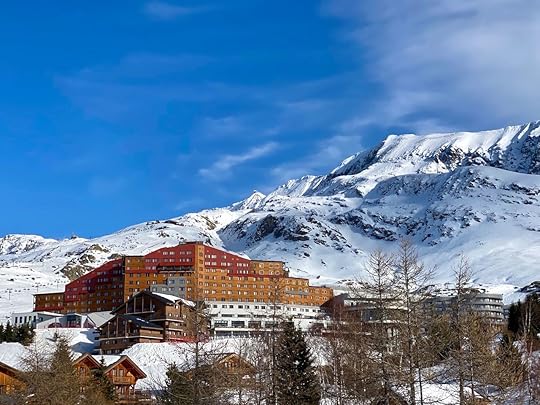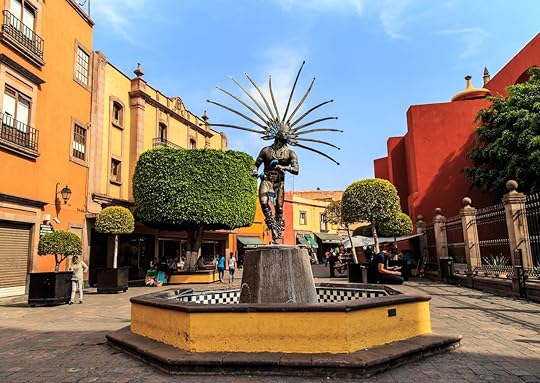Matador Network's Blog, page 932
January 29, 2020
Matador Network Cuba homage video

Talking about a Cuba vacation tends to be met with a response that goes something like this: “Wait, I thought we’re not allowed to go there,” or, “Isn’t that the place where everything is like, from the ‘50s?” Historically, a volatile political climate has made Cuba less-than-accessible to Americans, and there are still several criteria to be met before visiting the country, but the short answer is, “Yes, Cuba is accessible, and no, everything is not from the ‘50s.”

Photo: Scott Sporleder
When Cuba and the US formally re-established their relationship in 2015, it still was known as a place where you feel like you’ve traveled back in time. Classic cars lined the roads, movies were streamed in ‘90s-era resolution, and the phones weren’t exactly “smart.” But that’s all changing. As the country continues to open up, people are realizing that Cuba isn’t an antique novelty — it’s a place overflowing with adventure, music, and contemporary culture. Matador’s own Creative Director, Scott Sporleder, grabbed a camera and dove right in.
“We didn’t really know what to expect before we came down here to Cuba,” Scott says in the video, “but there’s no way I could have known it was gonna be this rad. The people, the music, the culture… these people know how to chill.”

Photo: Scott Sporleder
The film is called “Cuba. I love you, but you made me drink too much rum!,” and that title may as well be an open love letter to the country. It’s obvious where this love comes from. Whether it’s rolling cigars, dancing at karaoke bars, cruising along the coast, surfing, hitting the local markets, or, of course, drinking too much rum, Scott illuminates Cuba’s adventurous side — and it’s infectious.
“All I can say is thank you,” Scott concludes. “Thank you, Cuba, for a wild, wild trip. You’re a beautiful place.” 

More like this: 13 traditional Cuban foods more authentic than a Cuban sandwich
The post ‘I love you, but you made me drink too much rum!’ — a video homage to Cuba appeared first on Matador Network.

Rome Trevi Fountain barrier

Rome’s Trevi Fountain might be famous for its beauty, but it’s also famous for the hordes of tourists descending on it each day, trying to capture the perfect Instagram picture. And unfortunately, with crowds come damage both intended and unintended. To prevent tourists from sitting on the edge of the fountain, bathe in it, and otherwise defiling it, the Rome city council approved a resolution to erect barriers around the iconic monument.
Roman authorities hope that the barrier will put an end to the uphill battle of trying to preserve the fountain from reckless tourist behavior. Many, for example, have tried to swim in the fountain’s waters, in imitation of a scene from La Dolce Vita.
Some, like Italian architect and historian Paolo Portoghesi, are fiercely opposed to the barrier. “Installing a barrier,” he said, “seems a frightening offense to the beauty of a masterpiece that gives itself generously to those who observe it.”
According to the motion passed by the city council, “There must be respect for the symbolic parts of Roma Capitale,” as well as “continuous patrols” to make sure monuments aren’t being damaged. It also calls for a crackdown on street vendors around the fountain and Colosseum. 

More like this: 7 underrated churches in Rome that you need to check out
The post Rome is planning to build a barrier around the Trevi Fountain appeared first on Matador Network.

January 28, 2020
Earthquake causes Miami evacuations

A 7.7-magnitude earthquake rocked the Caribbean on Tuesday, striking south of Cuba and northwest of Jamaica. The quake is the strongest ever recorded by Cuban instruments, and the NWS Pacific Tsunami Warning Center has issued a tsunami threat for Belize, Cuba, Honduras, Mexico, the Cayman Islands, and Jamaica, warning of waves up to three feet above the tide level.
The quake was so powerful it was even felt in Miami, with some buildings undergoing evacuation due to safety precautions. In a tweet, the Miami Police Department said it was assisting firefighters with reported vibrations in the Brickell and downtown neighborhoods.
Jose Borrego, who was attending a meeting at the Bank of America building in Brickell, described his evacuation to CNN. “The evacuation was pretty smooth,” he said, “but all in all anxious about the state of emergency and the lack of information regarding the situation.” According to his account, he felt only a slight tremor inside the building but emerged to find that every building in the surrounding area was being similarly evacuated.
The timing of the earthquake couldn’t be more inopportune. As the city prepares for the Super Bowl this Sunday, media, fans, and sports figures are flocking to Miami ahead of the event though no injuries have yet been reported and, there appears to be no structural damage to buildings.
Of course, the bigger concern is toward the Carribean and the island countries directly affected. While no major injuries have been reported so far, we hope that continues to be the case and that a tsunami does not hit the area. 

More like this: Traveling during hurricane season? Here’s everything you need to know
The post 7.7-magnitude earthquake hits Caribbean, forces evacuations in Miami appeared first on Matador Network.

All-inclusive ski trips in the Alps

Maybe this year is finally the year you decide to organize a ski trip to the Alps. As appealing as the idea is, it can also be daunting. Not only do you have to decide on a ski area, but you also need to book flights and reserve lodging. Add in meals and, if you’re traveling as a family, ski lessons or babysitting — and the logistical and financial implications of a family Alps adventure start to sink in. To borrow a page from the beach vacation, an all-inclusive may be the easiest way to go.
The all-inclusive “answer”

Photo: Tomsickova Tatyana/Shutterstock
If you’re in the middle of an Alpine vacation planning fit, Club Med is here to help you. That’s the idea anyway. Club Med long ago ditched its 1960s reputation as a swinging singles beach destination and now focuses on all-inclusive, family vacations. Outside the US, it’s as well known for its ski properties as its beach locales. Club Med has 17 all-inclusive ski resorts in the French, Swiss, and Italian Alps, three in Japan, and one in China.
In December, we stayed at the Club Med Alpe d’Huez resort in the French Alps, not far from Chamonix and a two-hour drive from Geneva. Club Med Alpe d’Huez existed previously, but following a $110 million renovation, it reopened — on the day of our arrival — as a brand new “Four Trident” resort, to use Club Med’s own metric for its self-awarded luxury designation.
What do you get?

Photo: Noelle Alejandra Salmi
At its most basic, the Club Med all-inclusive ski package offers lodging, all meals, lift tickets, and Club Med “Children Clubs” for kids aged four to 17. It also offers, at additional cost, daycare for kids as young as four months — in brightly hued rooms with meals, activities, and even cribs for nap time. Ski lessons are also part of the standard package at Alpe d’Huez.
Also included in the standard package is some sort of evening entertainment, which will include things like an opening day après ski party and a psychedelic theater production called “Merlin” featuring Club Med employees. You’ll have plenty of food and drink. In addition to the buffet that you’ll visit three times a day, diverse snacks are laid out at happy hour. Hot tea and coffee are available at any time, and you can endlessly refill your draft beer mug at dinner. Beyond that, you’ll pay for wine and hard alcohol.
What’s good about it?

Photo: Gaspar Janos/Shutterstock
A plus of the Club Med model is “the convenience of not lugging equipment or worrying about ski tickets,” says Shekufeh Samii, a San Francisco resident who went to the Club Med in St. Moritz, Switzerland, with her husband and two daughters a few Februaries ago. She adds, “I’m very spoiled when it comes to skiing, so planning for a ski trip is a big chore for me. They make it easy if you want to ski with a group or an instructor, if you want to ski off-piste, everything is built into the system, so you just have to show up.”
Samii and her family were part of a bigger group of family friends taking a trip together, so the all-inclusive model was especially useful. “Not worrying about dinner reservations for 11 individuals or having to come to a consensus about what time or what kind of restaurants to go to in advance is a major plus,” she says.
Families with kids too young to ski often struggle with babysitting solutions. We’ve addressed some of the challenges of family ski vacations and noted that an all-inclusive is one answer. Even for parents who opt to put their, say, six-year-old in ski school, having it all be right there for you is handy. At 18, my daughter was too old for Club Med’s teen program, but many parents of tweens or younger teens might appreciate having their kids find some companions to hang out with.
The ski lessons/guides offered at Alpe d’Huez were a definite highlight. We joined a former Canadian Ski Team member and other experts in the off-piste groups. One sunny, post-snowfall morning, my daughter, two ski journalists from Colorado, and I donned our avalanche packs and joined Lionel, a local guide who’s made Alpe d’Huez his home for two decades. We carved fresh lines on wide open bowls, traversed along steep pitches to yet more untracked bowls, followed by steep couloirs, and all the while marveled at the immensity and beauty of Alpe d’Huez’s backcountry terrain.
What could be better

Photo: Noelle Alejandra Salmi
Samii said she didn’t find the food at the St. Moritz Club Med all that tasty. However, we thought the food at the Alpe d’Huez buffet was pretty good. This may have been due to the French influence — but Club Med says its chefs switch resorts every six months, so you won’t necessarily have a French head chef in France. Even with some flavorful options, the buffet did get tiring.
Because the all-inclusive model means you eat all your meals at the hotel, you have to go back there for lunch. It helps that Alp d’Huez is ski-in/ski-out, but with 441 guest rooms, the mammoth resort still required a longish walk from the ski lockers to the buffet area — and that was after you removed and stored your ski boots.
The bigger issue with heading back for lunch at the hotel is that, if you’re supposed to be skiing in the Alps, you should be enjoying some of the other things that make skiing in the Alps so spectacular. Two of those things are the sheer expanse of Alpine resorts and the laid-back food and drink culture.
When you head back to Club Med for lunch, you have less time to explore the far reaches of the Alpe d’Huez resort — or St Moritz, Val d’Isere, Cervinia, or whichever Club Med ski resort you hit up. Alpe d’Huez has over 90 square miles of skiable terrain, or 123 runs. If you really want to explore the massive area, turning around at 10:00 AM to be back at the buffet in time for lunch gets in the way.
It also means you aren’t enjoying those wine-soaked lunches out in the sunshine that skiing in the Alps is famous for. Your center of focus becomes not the charming alpine village your particular all-inclusive might be based in but the all-inclusive itself.
How to make it work for you

Photo: Noelle Alejandra Salmi
If you’ve booked your Club Med vacation well enough in advance, the pricing can be quite reasonable. According to Joseph Nuñez, PR and Partnerships Manager for Club Med, a stay at Alpe D’Huez costs $284 per night per adult. Book right now for a family of four in March and you could land at $7,300 all in for the week. (Over Christmas week next year, the highest peak pricing, that would be $10,000.) This price includes lodging, food, lift tickets, ski lessons, and the aforementioned entertainment. The earlier you book — six months or even a year ahead — the better the deal.
While the pricing is not bad, we think you should budget just a bit more for a few meals away from the resort. Take the time to explore whatever makes your chosen location special. Spend an afternoon, say, perusing the shops of your mountain village. Dinner at a place like Pizzeria Pinocchio in Alpe d’Huez will charm you with its cozy decor, surprise you at how good a pizza can be, and hardly make a dent in your wallet. (My daughter and my meal came out to $35.)
If it’s a sunny day, ask your ski guide to make a reservation for you at La Cabane. Sit outside — they’ll bring an extra blanket if you need it — and marvel at the mind-blowing mountainscape as you savor a warm goat cheese salad or caramelized pork ribs, washed down with a crisp local Altesse white.
If you’ve got young kids, make sure they take advantage of all of the Club Med kiddie offerings, including using the pool and everything else that little ones consider essential to an epic vacation. Non-skiers can use the cardio room free of charge and make appointments at the spa, which is an additional cost. Another goofy trick is to stick to one part of the buffet at time, so it feels a little more different from day to day.
Alternatives

Photo: ansharphoto/Shutterstock
Club Med isn’t the only all-inclusive — although few other ski hotels really offer what Club Med does. The Grand Hotel Zermatterhof advertises an all-inclusive offer for travel to Zermatt, Switzerland, one of the best resorts in the Alps. Along with your lodging, you get a seven-day ski pass, ski rentals, ski lessons, and a full breakfast buffet. (Other meals aren’t included.)
On the other hand, if you have an Ikon Pass ski pass from the US, you get five free ski days in Zermatt. Likewise, with an Epic pass, you can ski in Verbier, Switzerland, for five days or an entire week at France’s Trois Valles or Italy’s Skirama Dolomiti. Even without a US season pass, lift tickets in the Alps tend to cost less than in North America. A six-day, adult Alpe d’Huez ski pass purchased online comes out to $50 per day. At expensive Zermatt, beginners sticking to lower slopes can ski for $54, while experts who want to access the whole mountain can do so for $82. That ain’t cheap, but it isn’t Aspen or Vail pricing either.
Even with less expensive lift tickets, these resorts can be pricey for lodging and food. But look well in advance and you might find an apartment with a kitchen, where you can have most dinners. Shop in town and cook some of your meals, budgeting also for dinners in town and one of those famous Alps lunches on the mountain.
Of course, you would have to do a lot of the legwork yourself to go this non-inclusive route. It depends on you. There are many ways to make an Alps ski vacation work — all-inclusive or a la carte. 

More like this: The most unexpected, and awesome, places to ski around the world
The post How to decide if an all-inclusive ski resort is the best option for your Alps vacation appeared first on Matador Network.

Best dog breeds for the outdoors

If you’re an outdoorsy type, chances are you’re a dog person, and if you live in a mountain town, you know that dogs are as much a part of the outdoors culture as flannel and craft beer. But have you ever noticed that outdoorsy people seem to all have the same kinds of dogs? It’s logical, at least to a certain extent: Active, adventurous people are likely to get active, adventurous dogs. Still, most outdoorsy folks seem to gravitate toward the same handful of breeds — specifically huskies, labs, collies, heelers, and German shepherds — almost to the point of parody.
Obviously these prototypical adventure dog breeds have some advantages over the rest of the pack; they’re big, tough, energetic specimens that thrive on the rough-and-tumble lifestyles of their owners. But they’re not the only adventure dogs out there. If you’re in search of a four-legged friend to share in your active lifestyle, but you’re looking for something outside of the mainstream, consider one of these six seriously underrated dog breeds.
1. Standard poodle

Photo: everydoghasastory/Shutterstock
Don’t be fooled by the fluff. Poodles may not be the toughest-looking dogs around, but their prissy exterior belies a serious love for adventure. “Due to their majestic appearance, standard poodles are often stereotyped as fussy, high-maintenance dogs,” says Li-ran Bukovza, founder of PuppyTip. “In reality, this breed is happiest outside chasing squirrels and makes a great family pet.”
Originally bred as a duck-retrieving dog in Germany (their name derives from the German pudel, for “puddle”), the poodle’s extravagant coat was developed to insulate its body from cold water. And while their high stamina and superb swimming ability suit a life outdoors, their exuberant coats and exceptional trainability made them the darlings of European nobility, thus leading to the frivolous, even snobbish, image they suffer from today.
Regardless, Bukovza insists that adventurous owners shouldn’t be put off by the dog’s ritzy reputation. “Although they do need regular grooming, standard poodles aren’t afraid to get their paws dirty on an adventure!”
2. Jack Russell terrier

Photo: Larina Marina/Shutterstock
Averaging just 13-17 pounds fully grown, the Jack Russell terrier may not appear to be up for big adventures, but Bukovza says you shouldn’t be deterred from getting one. “While they may be small, you certainly won’t have to worry about a Jack Russell terrier keeping up with you!” Lisa Bernier of BARK, maker of the BarkBox, agrees. “These dogs are little, but boy do they have a ton of energy and grit.”
Also known as Parson Russell terriers, JRTs were bred as hunting dogs around 200 years ago in southern England. The breed’s creator, Reverend John “Jack” Russell, needed a dog quick enough to chase foxes above ground and tough enough to dig for them below. The result of his efforts was a bold, eager, and independent dog with boundless energy and a keen intelligence.
And while the JRT’s innate fox-hunting abilities may not be practical for the common adventurer’s life, there is still plenty of upside to the breed. “Jack Russells are fearless and tireless,” says Bernier. “They’re also small, so easy to travel with when it comes to flying in the cabin of a plane.” Bukovza agrees that their small size is ideal for more than just burrowing into fox dens. “They make a wonderful choice for someone who lives in a smaller space or wants a small breed, but still likes to run and play outside.”
3. Pyrenean shepherd

Photo: BIGANDT.COM/Shutterstock
Not to be confused with the towering, majestic great Pyrenees, the Pyrenean shepherd is a wiry, scrappy dog weighing no more than 30 pounds. For centuries, farmers and herders in the Pyrenees mountains between France and Spain employed the great Pyrenees and the Pyrenean shepherd in tandem, the former being used to guard flocks and the latter used to herd them. And while the Pyrenean shepherd might not cut as striking a figure as its impressive cousin, the Pyrenean shepherd, or Pyr shep, has a lot to offer the common adventurer.
As a herding dog, the Pyr shep has boundless energy and enthusiasm, yet it’s fiercely loyal and unlikely to stray far from its owner’s side. “Whether you run, hike, camp, or track, these dogs will love to be by your side,” says Steffi Trot, owner and head dog trainer at SpiritDog Training in Albuquerque, New Mexico. “They are definite one-person dogs and bond strongly to their owner.”
Pyr sheps are an ideal match for anyone who stays on the go outside. “They are incredibly agile and active and will happily participate in any outdoor activity,” says Trott. “They have strong endurance and surprising climbing skills.” Best of all? Apart from their need for speed, Pyr sheps are pretty easy to take care of and can adapt to their surroundings. “Their coat is very low-maintenance and keeps them warm even in winter weather and snow,” says Trott. “You don’t have to brush or wash it a lot, which makes it perfect for adventures.”
4. Dachshund

Photo: Lelusy/Shutterstock
For most people, the dachshund ranks somewhere near the bottom of adventure dog breeds, right along with the chihuahua and bichon frise. But for Jessica Williams, the blogger behind You Did What With Your Wiener?, the dachshund is a bona fide adventurer. “I’ve been hiking, camping, and traveling with my two miniature dachshunds for over 15 years,” says Williams. “My dachshunds have hiked up to 11 miles a day, sometimes over steep terrain, and had energy left over at the end. I’ve also done several multi-day hikes with them covering 25-30 miles in three days. I am the one that has a hard time keeping up with them!”
According to Williams, the dachshund’s grit and perseverance are a product of its history. “They were bred for hunting badgers and rabbits in the woods, which required them to be tenacious, physically active, and sometimes to cover miles and miles a day in the woods with their handlers,” she says. “They are stubborn and driven and see challenges as something to solve and overcome. They are truly small dogs with big personalities and physical abilities.”
Through her blog and Instagram, Williams says she hopes to challenge people’s preconceptions of the breed and push back on the idea that small dogs can’t do big things. Her feed is a veritable travel log for dachshunds Gretel and Summit through their home state of Washington — here beside Jade Lake, there atop Beacon Rock. In the bio Williams insists, “Small dogs hike too!” and, “No, I don’t have to carry them.”
“Dachshunds may be small and have short legs, but they have just as much energy as a big dog,” says Williams. “During our most recent hike, we had to climb over boulders up a steep creek drainage and pick our own path. I know many people that would not attempt what my little dog did.”
5. Beagle

Photo: Alexey Androsov/Shutterstock
With their cute, floppy ears and their happy-go-lucky dispositions, beagles have long been popular family dogs. In pop culture, beagles like Snoopy and Shiloh have endeared many to the breed, and today, it has more of a reputation as a playful backyard pet than a purebred adventure dog.
While the beagle has been around for centuries, little is known about its origins. According to the American Kennel Club, even the name “beagle” is shrouded in mystery. Some say it comes from the Gaelic word baeg, meaning “little”. Others say it comes from the French term for the sound the dogs make: be’geule. One thing is certain: The beagle has always been a hunter, primarily tracking deer and hares. “Beagles were initially bred to hunt in packs,” says Dr. Jennifer Coates, DVM, of Pet Life Today. “That history gives the modern beagle lots of energy, as well as a very friendly and social demeanor.”
That means that beagles are well suited to a variety of activities apart from hunting, and they also make great travel companions. “As long as they are healthy and in good shape, they can go, go, go all day long,” says Dr. Coates. “A beagle’s small stature also makes them relatively easy to keep up with on foot when you’re out on an adventure together, and they tend to be easier to travel with and take care of than larger breeds of dogs.”
6. Pembroke Welsh corgi

Photo: Sergii Kovalov/Shutterstock
The corgi has enjoyed a royal reputation for years because of Queen Elizabeth II’s devotion to the breed both in real life and on the hit series The Crown, but corgis have all the makings of a true adventure dog.
Corgis originated in Wales and were traditionally used to herd or drive cattle in rural areas. “Corgis are highly intelligent working dogs,” says Adinna Mullins, owner and head trainer at Blue Ridge Dog Training in Asheville, North Carolina. “They’re consistently recognized as one of the smartest breeds around. They like to have a job to do and enjoy quality time with their human counterpart, so taking them on adventures with you is a no-brainer.”
According to Mullins, the senses they honed over centuries of herding serve them well while on an adventure. “Their ears and eyesight give them incredible alertness,” she says. “And, their excellent herding abilities mean they have a great sense of direction, and they always know where home is — a critical skill for backcountry treks.” And lest you think that their short stature could disadvantage them on an adventure, Mullins insists their appendages are a positive. “Their stubby legs and meaty paws are not only a desirable trait for herding but also give them a low center of gravity. This comes in handy for adventures that require balance like stand up paddleboarding.”
No matter what breed you go with, make sure you consult with a vet to ensure your dog is a good fit for your lifestyle. While certain breeds are definitely more suited for an active life, every dog is different and factors like age and health history ought to be considered before you set off on your next adventure. And before you set out on your adventure, make sure your dog is equipped with all of the necessary gear and precautions, including water and a first-aid kit. 

More like this: How to go backpacking with a dog, according to an expert
The post 6 overlooked dog breeds that are perfect for outdoor adventure appeared first on Matador Network.

Things to do in Querétaro, Mexico

Santiago de Querétaro, or Querétaro for short, is the capital city of the Mexican state of Querétaro. It’s among the most historical cities in the country, with a city center so beautiful and well-maintained that it has UNESCO heritage status for its Baroque-style Spanish colonial architecture. Where Mexico City is sprawling and can be overwhelming, Querétaro is approachable, walkable, and doable in a couple of days. If you’re an early riser and have a vehicle, it’s possible to do Querétaro as a day trip from Mexico City — but with so much unique architecture and so many sights to see, it’s worth staying overnight. Here’s what to see.
Walk the UNESCO-listed city center.

Photo: Eleni Mavrandoni/Shutterstock
Santiago de Querétaro was founded in 1531, 12 years after Hernan Cortes began his overtaking of the Aztec empire. The city’s old town is the best-preserved of Mexico’s colonial-era cities, designed by the Spanish into two main zones — one for them, and one for the indigenous populations of the Chichimeca, Otomi, and Tarascan peoples. The old town is definitively Baroque, comprised of streets lined with pink stone row houses connecting multi-use public squares and hedge-lined gardens. As you walk the residential streets of Centro, it’s nearly impossible not to become jealous of the people living in these beautiful homes. Be sure to stop by the Zócalo, or town square, for a beer or coffee at one of the busy cafes overlooking the center. Bring a map, print or digital, with you on the walk because it’s easy to lose your way on the meandering streets.
As stunning as the brightly colored colonial homes are, Querétaro’s most famous architectural work is the massive, 18th-century aqueduct that runs through the heart of town. The aqueduct is over 4,000 feet long and made up of 75 massive arches, illuminated at night by bright spotlights that make the structure visible from any elevated point in town. Construction of the aqueduct was completed in 1738, and for over two centuries, it was used to carry water into Querétaro from the nearby El Ojo de Agua del Capulín spring. Despite no longer functioning in that capacity, it is preserved as a defining characteristic of the city’s facade. You can drive through the arches at multiple points in the city center, but it’s best viewed from the top of the Loma de Sangremal, a small hill opposite the Centro Histórico.
View the colonial-era churches.

Photo: Bildagentur Zoonar GmbH/Shutterstock
While getting your steps in walking the stone streets of Centro, head to Zenea Garden and the San Francisco Temple. This was the city’s first major temple to be constructed in the Baroque style, built in 1540, and today it houses the Regional Museum of Querétaro and its large collection of Pre-Columbian artifacts. The museum is open daily from 8:00 AM to 6:00 PM.
A few blocks away along Calle Independencia, the Santa Cruz Temple is adjacent to the Plaza de los Fundadores and located on the site where the Otomi indigenous peoples formally surrendered to the Spanish conquistadors. The temple and plaza see fewer visitors than the San Francisco temple but are of no less significance to the city’s history. In 1867, Austrian Emperor Maximilian, who ruled over Mexico for a short time under the direction of Napoleon III, was jailed in the temple after being captured by Benito Juarez’s troops, and he would be kept here while awaiting the firing squad that would end his life in July of that year, a symbolic end to colonial rule in Mexico.
Try enchiladas queretanas.

Photo: Playa del Carmen/Shutterstock
Be sure to stop at one of the many small cafes and restaurants surrounding Plaza Constitución and Jardin Guerrero. Querétaro is one of the best cities in the country for fans of traditional salsas — it would take the crown if it weren’t for Mexico City. Order a plate of carnitas, barbacoa, or tacos, and be ready for multiple types of heat. Querétaro also has its own style of enchiladas, known as enchiladas queretanas, with a sauce made of guajillo chiles, garlic, cumin, and oregano and a filling made primarily from ranchero or queso fresco. What makes them especially unique is the cooked potato and carrot topping. Many establishments also serve them filled with chicken or pork. Try them at Enchiladero on Circunvalación, a couple of blocks east of the Santa Cruz Temple.
If you have the time to get out of the city center, take an Uber up to Cerveceria Hercules, a massive brewery and food hall on the northeast end of town. Grab a beer and a table in the middle of its large courtyard. If you’re with the family or a large group of people, this is a great way to pass a couple of social hours, as there’s yard games, occasional live music, and plenty of space for kids to run around.
Check out a quirky museum.

Photo: Aberu.Go/Shutterstock
Querétaro’s museums aren’t as massive or introspective as those in Mexico City, but they’re every bit as engaging. Take the Zacatecana House Museum, which pays tribute to the design and artwork of the city and region’s early years. But local legend has it that the house in which the museum resides is haunted by the ghosts of the couple who lived there, following the husband’s mysterious disappearance and corresponding rumors that have endured ever since.
The city is also home to the world’s first museum dedicated solely to calendars, the Mucal Museum of Calendars. Like the Zacatecana House, this museum is located in a refurbished 17th-century home, but it houses thousands of calendars stretching as far back as the Aztecs. Another weird stop is the Querétaro Bugs Museum, which houses — as you likely guessed — a bunch of bugs. More than 2,000 species of bugs are displayed in cases and in frames on the walls, everything from beetles to spiders to butterflies.
Getting to Querétaro from Mexico City, and where to stay overnight

Photo: oculo/Shutterstock
The easiest way to get to Querétaro from Mexico City is by bus. Mexico has an intricate and well-managed system of bus transport, transporting passengers on very nice coach buses for as little as a few dollars, depending on how far you’re going. Multiple bus lines service the Querétaro Bus Terminal, much in the same way that airlines service an airport. Stick with Primer Plus, which runs the 4.5-hour route multiple times per day for about $18 each way. You can buy tickets at the station or in advance via the line’s website. You can also fly between the two cities in about an hour but will have to shell out between $100 and $200.
Uber is readily available in Querétaro, though the city is by and large a safe place to be — it’s among the wealthiest of the capital cities in Mexico and a gateway for some to the tourist hotspot of San Miguel de Allende, just a 90-minute drive away. Querétaro’s city center offers many hotels, but for the most unique experience, book an Airbnb in one of the homes in the UNESCO-certified Centro or Centro Historico neighborhoods. Expect to pay $40-$50 per night for a one-bedroom apartment with a kitchen. 

More like this: The largest pyramid in the world isn’t in Egypt. It’s in Mexico.
The post How to spend one perfect overnight trip to Querétaro from Mexico City appeared first on Matador Network.

Banana dishes from Uganda

Uganda might be famed as the last frontier of mountain gorillas, along with neighboring Rwanda and Democratic Republic of Congo, but what you might not know about this country is that it is also home to a complex cuisine. When it comes to breakfast, lunch, and dinner, bananas reign supreme. Whether you’re hankering for a roadside snack on the bustling streets of Kampala or enjoying dinner at a high-end restaurant overlooking the skyline, or even sharing a meal at a local household, you’re sure to find bananas on the menu. Uganda is known to grow more than 50 varieties of bananas and has perfected its culinary craft to draw different tastes from this assortment. Here are nine Ugandan dishes (and drinks) that incorporate bananas.
1. Matooke

Photo: Dedan Miricho/Shutterstock
Matooke is a ubiquitous dish in Uganda. Green bananas are peeled and wrapped in banana leaves like a gift. The wrapped bananas are then placed in a pot lined with banana stems and filled with a small amount of water. Finally, the pot is covered with banana leaves. The bananas are steamed for at least an hour. Still wrapped, the bananas are mashed by gently pressing them with open hands. The mashed bananas are returned to the same pot to steam for another 40-50 minutes to accentuate their flavor. This cooking process is called okubobeeza etooke. The steamed bananas are served with either bean stew or oluwombo (a stew of chicken, goat meat, or beef) with a side of ebinyeebwa (peanut sauce).
2. Katogo

Photo: Nickolas warner/Shutterstock
Katogo is a stew, typically served as breakfast. Onions, tomatoes, pepper, eggplants, courgettes, and green pepper are combined in a pan until a thick sauce forms. Leafy green vegetables or beans are added to the mixture, followed by peeled green bananas and water. The stew is cooked until the bananas become tender and turn yellow.
3. Gonja

Photo: Svetlana Bykova/Shutterstock
This simple yet flavorful dish is made with ripe plantains called gonja that are either roasted, deep-fried, boiled, or baked. Similar to matooke, it is served with either a stew of beans or oluwombo and ebinyeebwa to balance its sweet taste. Another breakfast item not to miss.
4. Kabalagala
Although in Uganda they are known as pancakes, these popular breakfast pastries are akin to doughnuts. Ripe dessert bananas, small in size and locally known as ndiizi, are mashed in a bowl and mixed with cassava flour to form a non-sticky dough. It is rolled to form a flat circular shape with a thickness of approximately two inches. A cookie-cutter is used to cut out circular shapes, which are deep-fried for three to five minutes or until golden brown. They are served hot. Since cassava has a very mild taste, the sweet bananas lend their distinctive natural sweetness.
5. Roast bananas

Photo: Nickolas warner/Shutterstock
Everywhere you step in Kampala, the capital of Uganda, there are roadside vendors selling a huge stack of roast bananas as a simple snack. Green bananas are roasted or barbecued over hot coals until they become tender. This delicacy is best enjoyed hot at any time of the day.
6. Banana cake
Banana cake can be served for breakfast, at tea time, or as a dessert. In Uganda, banana cake tastes and looks just like any banana bread that you’ll find in the West: not too sweet, light, fluffy, and suitable as a daytime snack or an after-dinner treat.
7. Banana chips

Photo: Tatiana Volgutova/Shutterstock
Banana chips in Uganda are similar to those you’ll find in many other countries that enjoy snacking on bananas, like India and Indonesia. In Uganda, chips are mostly made of deep-fried plantains. Thin slices of ripe or unripe bananas are cut either across to form small circular pieces or along to make long pieces. They are deep-fried until they are golden brown (if ripe) or gold-yellow (if unripe). They are served cold on a platter.
8. Tonto

Photo: Mariya Sukhoveyko/Shutterstock
Tonto is banana beer, a local brew made from bananas, particularly the kanyinja variety predominant in Central Uganda. A bunch of mature bananas are cut and stored for about seven to eight days to ripen. The ripe bananas are placed in a wooden trough and pressed with bare feet to extract juice: a process very similar to wine-making. In this case, elephant grass is used to facilitate the sieving process. The juice extract is poured back into the wooden trough, and millet is added as a fermentation agent. The mixture is then covered with banana leaves and left to ferment for two days. The alcohol is preserved in a gourd, which also serves as a decanter. Tonto plays a significant role in Ugandan culture: During a traditional marriage ceremony, for instance, the groom must present three gourds of this beer.
9. Omubissi
In the Western world, it might not be intuitive to juice a banana, but in Uganda, the practice is common. The procedure of extracting banana juice is similar to the beer-making processes — and it’s usually all done by hand. Mature bananas are harvested then stored in dugout holes in the ground, which are covered with banana leaves to speed up the ripening process. The ripe bananas are then peeled and mixed with elephant grass in large bowls. The juice extract is then diluted with water and served cold. 

More like this: No celebration in Kenya is complete without fermented porridge
The post 9 sweet, stewed, and mashed Ugandan banana dishes to try appeared first on Matador Network.

LGBTQ guide to Honolulu, Hawaii

The Honolulu LGBTQ community truly embodies the aloha spirit — one of love, friendship, and acceptance. In fact, same-sex and bisexual relationships have been present and widely accepted in Hawaiian culture dating back to ancient times. The term aikāne defines such relationships in the Hawaiian language, and māhū refers to a “third gender” alongside male and female.
Today, Hawaii is known for its welcoming culture and is home to many LGBTQ-friendly establishments, events, and festivals, including October’s PRIDE festival, which brings an impressive parade and parties all weekend long. Your trip to Oahu will be hotter than the Waikiki sun with this comprehensive guide to the best places to experience Honolulu’s unique queer culture, from bars to restaurants, nightlife to daytime, and adventures and places to stay.
Restaurants, bars, and nightlife
Hula’s Bar & Lei Stand

Photo: Hulas Bar And Lei Stand/Facebook
Known as the “gathering place for explorers,” this friendly gay bar is a welcoming destination for everyone. The long windows open to a gentle Waikiki breeze and stellar view of the Pacific for an oceanfront dining experience. In the evening, live music, a large dance floor, and drink specials keep the aloha spirit flowing. Be sure to check the site for upcoming events. including weekly catamaran cruises.
Where: 134 Kapahulu Ave.
Scarlet
Scarlet is the quintessential hub of Honolulu’s LGBTQ community and the epitome of the welcoming culture of the islands. Locals say there is truly never a bad night at Scarlet. With shows every Friday and Saturday night, renowned queens and kings take the stage for the Fresh Fish Drag Revue and beats that keep clubgoers dancing until the wee hours of the morning.
Where: 80 S. Pauahi St.
Lulu’s
Conveniently located right next door to Hula’s Bar & Lei Stand, Lulu’s is an LGBTQ-friendly restaurant and bar featuring basic American fare with an island twist. Order the Aloha Burger with pineapple, teriyaki sauce, and grilled onions or opt for the Adulting Mac n’ Cheese with bacon crumbles for a true indulgence — you won’t be disappointed. The restaurant turns into a nightclub on Monday night for industry night, and locals from all around the island congregate for dancing and drink specials until 2:00 AM.
Where: 2586 Kalakaua Ave.
Wang Chung’s Karaoke Bar

Photo: Wang Chungs Karaoke Bar/Facebook
Wang Chung’s is a close-knit Waikiki gay bar tucked into the back of the Stay Hotel lobby. This lively hideaway’s menu is full of creative cocktails, pizzas, and comforting bites, and its famous Sunday drag brunches guarantee a good time. And for those who wish to show off their vocal abilities, the mic is always passed around for daily karaoke.
Where: 2424 Koa Ave.
In Between
For an intimate bar experience, pull up one of a dozen or so seats at In Between. Referred to as the “friendliest gay bar in Waikiki,” this no-frills hideaway bar features happy hour until 8:00 PM. Bartender Sabrina’s rotating selection of dessert shots are delicious and include creations such as apple butterbeer and orange creamsicle.
Where: 2155 Lauula St.
Blazing Saddles
Cowboy boots are more than welcome at Blazing Saddles, Hawaii’s only LGBTQ western dance club. Blazing Saddles prides itself on being a non-profit organization committed to providing a safe, fun, and friendly environment where all are welcome. There’s no cover charge, but donations are gratefully accepted. Each night is filled with live music, refreshments, and dancing. Go early for free dance lessons starting at 6:30 PM.
Where: 404 Kapahulu Ave.
Bacchus
This casual, natural-wood-adorned gay bar hosts myriad community events, including monthly catamaran cruises, trivia, live music, and other entertainment in a setting where respect and inclusion are championed. Don’t miss nightly drink specials such as $4 Margarita Mondays, Wednesday “Airport Double” $3 doubles, and Flirty Friday’s two-for-one happy hour from 5:00 to 8:00 PM.
Where: 408 Lewers St.
Beaches and outdoor adventures
Hawaii is known for its beaches and surrounding mountains, and no vacation to the islands would be complete without thorough relaxation on the sand or a muddy hike or two. While not all of the beaches, hikes, and adventures listed here are specific to the LGBTQ community, these landmarks are safe spaces for all featuring some of the best views and traditional Hawaii vacation experiences Oahu has to offer.
Hike Koko Head Crater Trail

Photo: itsflowingtothesoul/Shutterstock
The infamous Koko Head Crater, otherwise known as nature’s StairMaster, is an unmissable hike just south of Waikiki. This trail leads straight up retired tracks with rewarding panoramic views of the coastline and mountains from the top. It is recommended to begin hiking later in the day — after the noontime heat — and be sure to take time at the top to enjoy an unforgettable sunset.
Kaimana Beach
Kaimana Beach, known as Kaimanas to the locals, is the go-to beach on the edge of Waikiki next to the Otani Kaimana Beach Hotel. The reef blocks the big waves, creating a calm pool for swimming and wading. There is a lifeguard on duty and showers to rinse off sand before heading to the bar for a cold one.
Where: 2863 Kalakaua Ave.
Polo Beach

Photo: Circumnavigation/Shutterstock
One of the most unique and secluded beaches on Oahu, Polo Beach is known as a friendly, welcoming, and popular nude beach perfect for those looking for the no-tan-lines life. It is located off of Farrington Highway across from Dillingham Lodge, next to the Polo Club in Mokuleia. Head down the access path and to the far right for the nudist area. There are no services or amenities in the area, so be sure to pack plenty of water, snacks, and SPF.
Where: Farrington Highway, Mokuleia
Places to stay
Hawaii is no longer known for just resort-studded beaches. In Waikiki, smaller boutique hotels now dot the famous coastline. Bright and minimalist interiors are peaceful while hotel bars and pools allow guests to join the vibrant Honolulu social scene at each of these carefully curated chain and independent hotels.
The Surfjack Hotel & Swim Club

Photo: The Surfjack/Facebook
Featuring the iconic “Wish You Were Here” pool, the Surfjack Boutique Hotel and Swim Club is a favorite hotel for both visitors and stay-cationers alike. Even if you don’t happen to have a room, come lounge at the weekend pool parties, gay-friendly and welcoming to all.
Where: 412 Lewers St.
The Laylow, Autograph Collection
Mid-century modern meets Hawaiian charm at The Laylow, Autograph Collection, a welcoming and LGBTQ-friendly hotel in the heart of Waikiki. Here all guests receive a gift basket chock-full of local kine snacks and a pair of Laylow’s signature “slippas” upon arrival, a true sign of Hawaiian hospitality. Before heading out on the town, sip flower-adorned craft cocktails at the bar, a place to see and be seen in Waikiki.
Where: 2299 Kuhio Ave.
‘Alohilani Hotel

Photo: Alohilani Resort Waikiki Beach/Facebook
Nearly every room of the ‘Alohilani Hotel offers ocean and Diamond Head Views from private lanais. And if you are visiting in October, the fifth-floor pool deck hosts the annual Lei Magazine Pride Pool Party, during which you can join hundreds from the Honolulu LGBTQ community for festivities. Outside of this event, The hotels Swell Pool and Bar has a great cocktail list, saltwater infinity pool, and cabanas for a chill but luxurious lounging experience. And weekly Sunday pool parties are open and welcome to all.
Where: 2490 Kalakaua Ave.
Aqua Skyline at Island Colony
The General Manager and many of the front line staff are LGBTQ members at this ultimate gay hotel, a proud partner of many LGBTQ organizations in Honolulu. For gay travelers, being located walking distance from many of the most popular LGBTQ bars and restaurants means no boredom will ensue. Rooms come complete with kitchenettes for a home-away-from-home feel.
Where: 445 Seaside Ave.
The Hilton Waikiki Beach Hotel
A partner of the International LGBTQ Travel Association since 2010, Hilton hotels are known to be welcoming to LGBTQ travelers. This hotel is famous for its panoramic views and quintessential Hawaiian hospitality, warmly greeting travelers of all kinds. Located just one block from the beach and steps from many iconic gay bars in Waikiki, the hotel serves as the perfect launchpad for any big gay vacation. For those who enjoy a late-night snack after a night out, the classic all-day and all-night diner M.A.C 24/7 is all-too conveniently located off of the lobby.
Where: 2500 Kuhio Ave.
Hyatt Centric Waikiki Beach

Photo: Hyatt Centric Waikiki Beach/Facebook
Home of Gay Island Guide’s monthly Super Slyde Pool Party, the fun never stops at Hyatt Centric. Floor-to-ceiling windows in each room offer views of iconic Waikiki Beach amongst contemporary decor. The lounge pool features private cabanas and a tapas-style eatery for small bites between play. And this LGBTQ-friendly hotel is a proud partner of Honolulu PRIDE Festival.
Where: 349 Seaside Ave.
Events and festivals
ARTafterDARK at Honolulu Museum of Art

Photo: Honolulu Museum of Art/Facebook
Organized by a dedicated group of young volunteers, this welcoming, must-attend event falls on the last Friday of each month. Live music, art, craft cocktails, and small plates are inspired by a monthly theme, and each courtyard features a unique experience led by a local band or artist.
When: Last Friday of each month
Aloha Bears Booze Cruise
Every second Sunday of the month, the Aloha Bears host a 1.5-hour-long open bar booze cruise along Waikiki. The cruise is open and welcome to all. The ticket includes lunch and a few more cocktails afterward at Bacchus. Tickets are available for purchase in advance online, and sailors meet at Bacchus before walking over to the boat together.
When: Second Sunday of the month
Hula’s Catamaran
Hula’s World Famous LGBTQ catamaran ride cruises along the waters of Waikiki every Saturday at 2:00 PM. Mai tais and beer are available for purchase onboard. It is recommended that tickets be purchased a couple of weeks in advance and can be obtained online for $25. The group meets outside of Hula’s Bar & Lei Stand.
When: Every Saturday
SuperSlyde Pool Party

Photo: Gay Island Guide/Facebook
Known as “The Best Pool Party in Hawaii,” the monthly Gay Island Guide SuperSlyde Pool Party at the Hyatt Centric Waikiki Beach brings together everyone from all aspects of the community for sun and fun. Top DJs, special guests, and local entertainers keep the party going well into the night.
When: Monthly
The Aloha Classic
This LGBTQ-friendly pick-up-style football tournament brings together seasoned players and newbies alike for a weekend of fun, football, and shenanigans. The festivities begin with an opening party on Thursday, February 13, and end with the Recovery Beach Barbecue in Waikiki on Monday, February 17.
When: February
Honolulu PRIDE

Photo: Honolulu Pride/Facebook
While most cities celebrate PRIDE Month in June, Hawaii opts for October — one of the best months of the year to visit Hawaii when the rush of the summer is over, and the holiday excitement has not yet arrived. This one week in October culminates with a Pride Parade down Waikiki’s Kalakaua Avenue where hundreds of floats from Pride supporters, companies, and organizations let their freak flags fly. The parade ends at the Waikiki Shell for Pride Fest with live music, dancing, vendors, food, and beverages to continue the celebration. PRIDE 2019 was the largest of the festival’s 28-year history with over 30,000 spectators and over 30 cultural, social, and educational events hosted by LGBTQ Legacy Foundation sponsors, partners, and the community.
When: October 

More like this: The top 10 LGBTQ destinations for 2020
The post The ultimate LGBTQ guide to Honolulu, Hawaii appeared first on Matador Network.

UK to legalize e-scooters

Currently banned from roads and sidewalks in the UK, the controversial electric scooters that have taken over the streets of cities in North America and Europe are likely going to be legalized soon in an effort to promote green transportation.
A consultation will be held next month regarding potential regulation, and following the consultation, fleets of e-scooters will be tested in cities around the UK. They would, however, be prohibited from traveling faster than 15.5 mph and would only be allowed on roads and cycling lanes. It is yet to be determined if the use of a helmet will be made mandatory.
E-scooters tend to be a controversial subject. Some people love them, as they offer a convenient way to explore a city in the absence of a car, while others tend to despise them, as e-scooter riders often ride recklessly and abandon their scooters on sidewalks. The UK hasn’t had to grapple with this issue just yet, but that’s about to change.
There are, however, safety concerns surrounding the vehicles. According to iNews, there have been at least 10 serious injuries and 21 slight injuries involving e-scooters in London in 2019.
Indeed, should the UK follow through with legalization, safety and responsible operating are sure to come to the forefront of the conversation. 

More like this: The best places in Italy to explore by scooter
The post UK set to legalize e-scooters in an effort to encourage green transport appeared first on Matador Network.

Super Nintendo World at Universal

Details about the long-rumored fourth park at Universal Orlando have finally been announced. After months of speculation, it has finally been revealed that Universal’s new park will feature Nintendo characters. Slated to open in 2023, the park will span 750 acres, employ 14,000 workers, and is expected to draw millions of new visitors. The new park will be located a few miles away from the existing Universal Studios property.
A similar Nintendo park is opening this year at the Universal Studios park in Osaka, Japan, featuring interactive gameplay, rides, and shops. Guests are able to download a phone app to more closely engage with the park’s interactive experiences, including collecting digital coins and playing against others in the park.
Thierry Coup, the senior vice president and chief creative officer at Universal Creative, said, “You’re not just playing the game; you’re living the game, you’re living the adventure. Nintendo’s most iconic locations and experiences will be brought to life, including Mushroom Kingdom, Peach’s Castle, an incredible Mario Kart ride, Bowser’s Castle — and more.”
Beyond the vague features already revealed, fans are now left to speculate what other elements from the Nintendo Universe may be included. Remember, Nintendo isn’t all about Mario. Guests can also expect Pokemon to play a significant role in the park’s additions. 

More like this: The 7 strangest theme parks around the world
The post Super Nintendo World officially announced by Universal Studios Orlando appeared first on Matador Network.

Matador Network's Blog
- Matador Network's profile
- 6 followers



